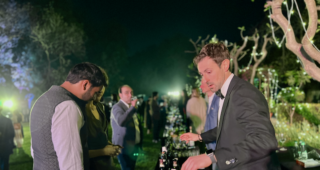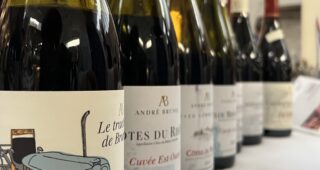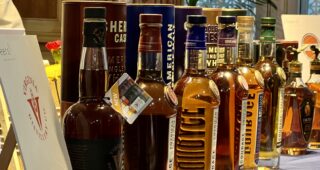Visualise this- you’re with your best buddies in a cosy bar around a good bottle of wine, sharing memories of the yore and wishing that time would just hold. The wine is truly pleasing and you request the sommelier for a refill – insisting the same on your friends who relent, albeit with a ‘one too many’ refrain. And the evening turns out to be one of the most memorable ones.
Now imagine the same wine that you enjoyed, being served at an al fresco tasting for connoisseurs. The temperature of the wine is just right, the air is pristine with virtually no ambient aromas as you tilt the glass to notice that the wine is more garnet than ruby, even as your fellow connoisseur lists out his preference for French oak against American. Does the wine feel any different? Probably so.
We often get influenced by the intangible factors related to tasting wine, apart from the rudimentary 5 ‘S’s viz. See, Sniff, Swirl, Sip and Swallow. These factors work at a subconscious level to determine our interpretation of a wine.
A few posts back, I had dwelled leisurely on this subject through a wine that I had the opportunity to appreciate in two distinct environs situated oceans apart. Here is a recap:

In either of the cases the wine expressed different traits. While at Château de la Marquetterie, it came across as a chic dessert indulgence with an interwoven piece of history, at Oval bar it was a très moderne experience amid club causerie. To read the experience in details click here to access the relevant post.
Taking the theory further
In a recent article in The Drinks Business, I came across another interesting connotation of such external stimuli on wine. It talks about an ongoing research by a leading experimental psychologist on exploring the impact of different stemware textures on people’s experience of drinks.
The psychologist, Mr. Spence is the director of the Crossmodal Research Laboratory at Oxford University’s Department of Experimental Psychology. According to Spence, he is currently playing a lot with texture and feel, for example, glassware manufactured with textured rims or lips, to look into “things you feel while you are tasting”.The new emphasis follows extensive work with leading chefs, where Spence has found that touching different fabrics can affect the taste sensations of diners.
To elaborate on this idea, he cites the following experiments :
- Using different fabrics swatches to affect the language used for describing wines- like ‘velvety’ for describing a red wine’s tannins.
- Etching or bevelling wine glasses to explore the influence of texture on the drinker’s experience.

The idea may appear abstract, but consider it in the light of tactile influences in other domains and it becomes perfectly plausible. For instance, a thick rimmed leather covered steering wheel of an automobile that gives a ‘chunky’ feeling of reassurance not necessarily related to its functionality. Ditto for an uber slim key board of an iMac imparting a luxury experience inconsequential to the task outcome. Related to wine, this is perhaps why we sub consciously form a favourable opinion of one with a sturdy textured label on the bottle even before sampling it.
The Price Effect
In yet another study on the effect of external stimuli on wine appreciation highlighted by Matthew Keiran, scientists at the California Institute of Technology and the University of Stanford conducted a distinctive wine tasting where subjects were told they would be asked to sample five different Cabernet Sauvignons to study the relationship between tasting time and perceived flavours. As each different wine was served, it was identified by its supposed price, ranging from $5 to $90. However, there were only three different wines involved. Two wines were served twice, one marked with its actual price ($5) and alternatively a 900% mark up ($45), another with its actual price ($90) and a 900% mark down ($10). All subjects reported being able to taste five distinct wines and the more expensive the price cue for a wine was, the more subjects liked it.
The pleasure apparently derived by the subjects in tasting the wine was significantly affected by its perceived price. Sounds familiar?
Some may argue that lack of wine experience may result in situations like the above. But even the most seasoned wine connoisseur would acknowledge that at a blind tasting, zeroing down on a wine to the granularity of its detailed provenance is an outcome heavily dependent on the chance factor. I distinctly remember a wine knowledgeable gathering (of which I happened to be a part) tasting Bordeaux blends in which there was a surprise inclusion of a Beaujolais Villages wine. I thought of it as a Bordeaux Clairet due to its noticeably low tannin extraction, and by believing that only Bordeaux blends were being served at the tasting. The theme of tasting had clearly polarised my mind towards the Bordeaux region. The solace however, was that I had at least noticed the generic style of the wine.
Getting influenced by others’ opinions
More recently in 2016, I attended a tasting in the company of some of the top wine professionals where one of the accomplished sommeliers declared a wine as being ‘corked’. There was a tendency by some to analyse the wine in the same light and second the opinion. That the wine was ‘corked’ or otherwise is a different issue, but the episode served as a good example of getting influenced by others’ opinions- while tasting wine. Another common example of such an influence would be guided tastings conducted by experts where the audience tends to follow a similar aromas/flavour profile path which the expert steers it towards.
Accept or deny, intangible factors in wine appreciation are a reality. It is only a matter of being conscious of these intangibles to be able to interpret a wine justly.
The way mother nature intended it to be- using all our faculties while perceiving the outer world!









